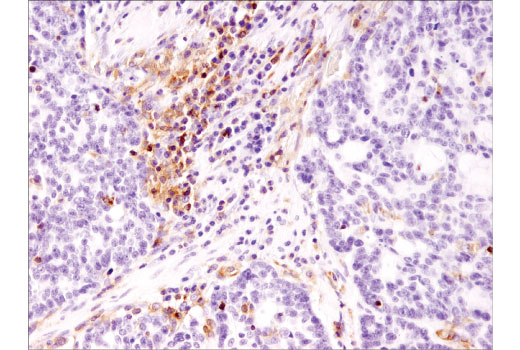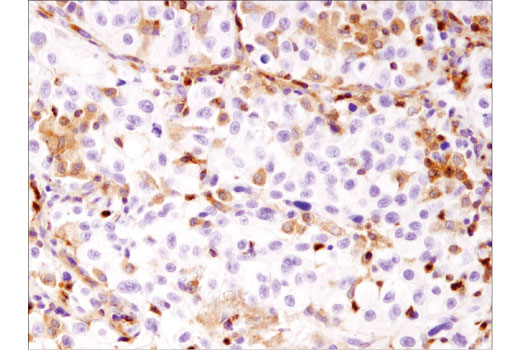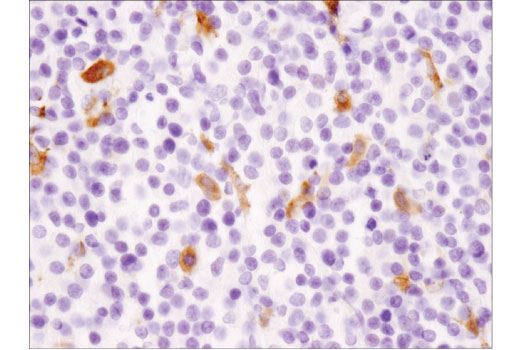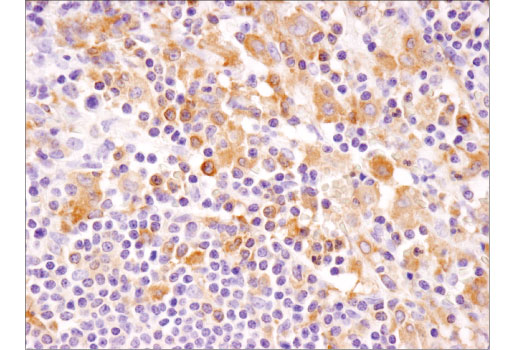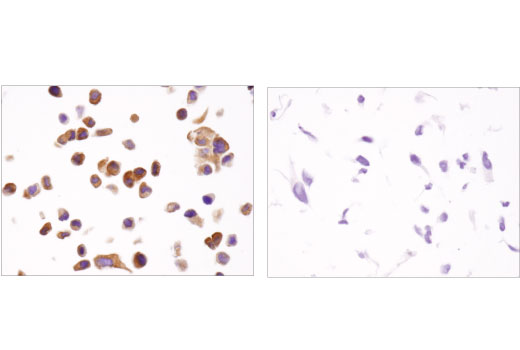IHC-P
H
Endogenous
190, 110
Rabbit IgG
#Q8TCU6
57580
Product Information
Product Usage Information
| Application | Dilution |
|---|---|
| Immunohistochemistry (Paraffin) | 1:150 |
Storage
Specificity / Sensitivity
Species Reactivity:
Human
Source / Purification
Monoclonal antibody is produced by immunizing animals with a synthetic peptide corresponding to residues surrounding His770 of human PREX1 protein.
Background
Phosphoinositide-3,4,5-triphosphate (PtdIns(3,4,5)P3)-dependent Rac exchanger 1 (PREX1) is a Rac-specific GTP-exchange factor (GEF) regulated by heterotrimeric G-protein β/γ subunits and the lipid second messenger PtdIns(3,4,5)P3 (1-4). PREX1 contains two DEP (Dishevelled, Egl-10, and Pleckstrin homology) domains that coordinate heterotrimeric G-protein signaling. It also contains a Dbl-homology domain, which exhibits Rac-GEF activity, and PH and PDZ domains for interacting with upstream and downstream signaling components (1). Originally shown to modulate cellular migration of neutrophils by Rac2 activation (5-8), it is clear that PREX1 plays a broader role in modulating cell migration. PREX1 promotes metastasis of prostate cancer and melanoma cells, affects endothelial junction integrity, and is required for platelet generation and function (9-14). Research studies suggest that PREX1 plays an essential role in mediating ErbB-dependent signaling events in breast cancer by coordinating Rac activation in response to paracrine signals within the tumor microenvironment. Activation of PREX1 downstream of ErbB3 and EGFR chemokine receptors (CXCR4) promotes Rac activation, increased migration, proliferation, tumorigenesis, and metastasis in breast cancer cells (15,16). Consistent with this observation, deletion of PREX1 expression in mice results in resistance to melanoma metastasis (11). Expression of PREX1 in human tumors transplanted into mice inversely correlates with increased tumor progression and poor survival (15). Additional research studies suggest that PREX Rac-GEF activity is enhanced by phosphorylation in response to growth factors or hormones, and may require coincident dephosphorylation of two PH domain serine residues. The upstream kinases and precise regulatory mechanism remains elusive (15,17).
- Welch, H.C. et al. (2002) Cell 108, 809-21.
- Hill, K. et al. (2005) J Biol Chem 280, 4166-73.
- Mayeenuddin, L.H. and Garrison, J.C. (2006) J Biol Chem 281, 1921-8.
- Barber, M.A. et al. (2007) J Biol Chem 282, 29967-76.
- Welch, H.C. et al. (2005) Curr Biol 15, 1867-73.
- Dong, X. et al. (2005) Curr Biol 15, 1874-9.
- Zhao, T. et al. (2007) J Leukoc Biol 81, 1127-36.
- Nie, B. et al. (2010) Cell Signal 22, 770-82.
- Qin, J. et al. (2009) Oncogene 28, 1853-63.
- Wong, C.Y. et al. (2011) J Biol Chem 286, 25813-22.
- Lindsay, C.R. et al. (2011) Nat Commun 2, 555.
- Qian, F. et al. (2012) Arterioscler Thromb Vasc Biol 32, 768-77.
- Naikawadi, R.P. et al. (2012) Circ Res 111, 1517-27.
- Campbell, A.D. et al. (2013) PLoS One 8, e53982.
- Montero, J.C. et al. (2011) Oncogene 30, 1059-71.
- Sosa, M.S. et al. (2010) Mol Cell 40, 877-92.
- Montero, J.C. et al. (2013) Cell Signal 25, 2281-9.
Species Reactivity
Species reactivity is determined by testing in at least one approved application (e.g., western blot).
Applications Key
IHC-P: Immunohistochemistry (Paraffin)
Cross-Reactivity Key
H: human M: mouse R: rat Hm: hamster Mk: monkey Vir: virus Mi: mink C: chicken Dm: D. melanogaster X: Xenopus Z: zebrafish B: bovine Dg: dog Pg: pig Sc: S. cerevisiae Ce: C. elegans Hr: horse GP: Guinea Pig Rab: rabbit All: all species expected
Trademarks and Patents
Limited Uses
Except as otherwise expressly agreed in a writing signed by a legally authorized representative of CST, the following terms apply to Products provided by CST, its affiliates or its distributors. Any Customer's terms and conditions that are in addition to, or different from, those contained herein, unless separately accepted in writing by a legally authorized representative of CST, are rejected and are of no force or effect.
Products are labeled with For Research Use Only or a similar labeling statement and have not been approved, cleared, or licensed by the FDA or other regulatory foreign or domestic entity, for any purpose. Customer shall not use any Product for any diagnostic or therapeutic purpose, or otherwise in any manner that conflicts with its labeling statement. Products sold or licensed by CST are provided for Customer as the end-user and solely for research and development uses. Any use of Product for diagnostic, prophylactic or therapeutic purposes, or any purchase of Product for resale (alone or as a component) or other commercial purpose, requires a separate license from CST. Customer shall (a) not sell, license, loan, donate or otherwise transfer or make available any Product to any third party, whether alone or in combination with other materials, or use the Products to manufacture any commercial products, (b) not copy, modify, reverse engineer, decompile, disassemble or otherwise attempt to discover the underlying structure or technology of the Products, or use the Products for the purpose of developing any products or services that would compete with CST products or services, (c) not alter or remove from the Products any trademarks, trade names, logos, patent or copyright notices or markings, (d) use the Products solely in accordance with CST Product Terms of Sale and any applicable documentation, and (e) comply with any license, terms of service or similar agreement with respect to any third party products or services used by Customer in connection with the Products.
